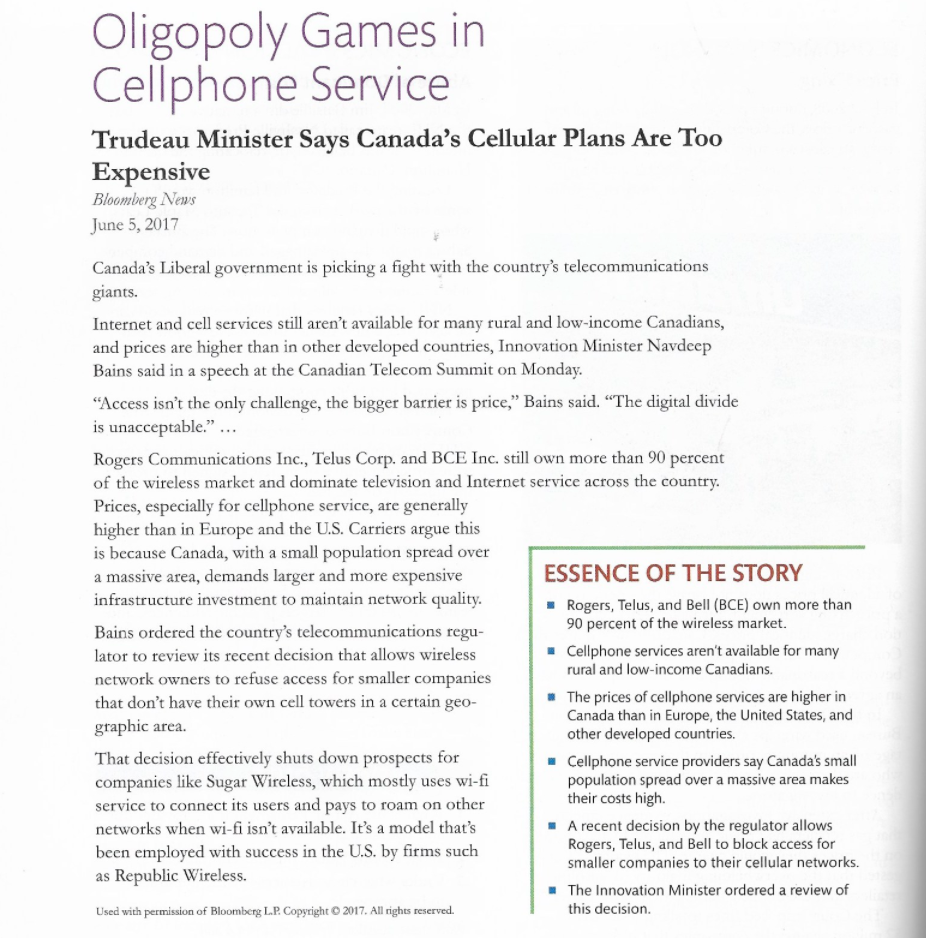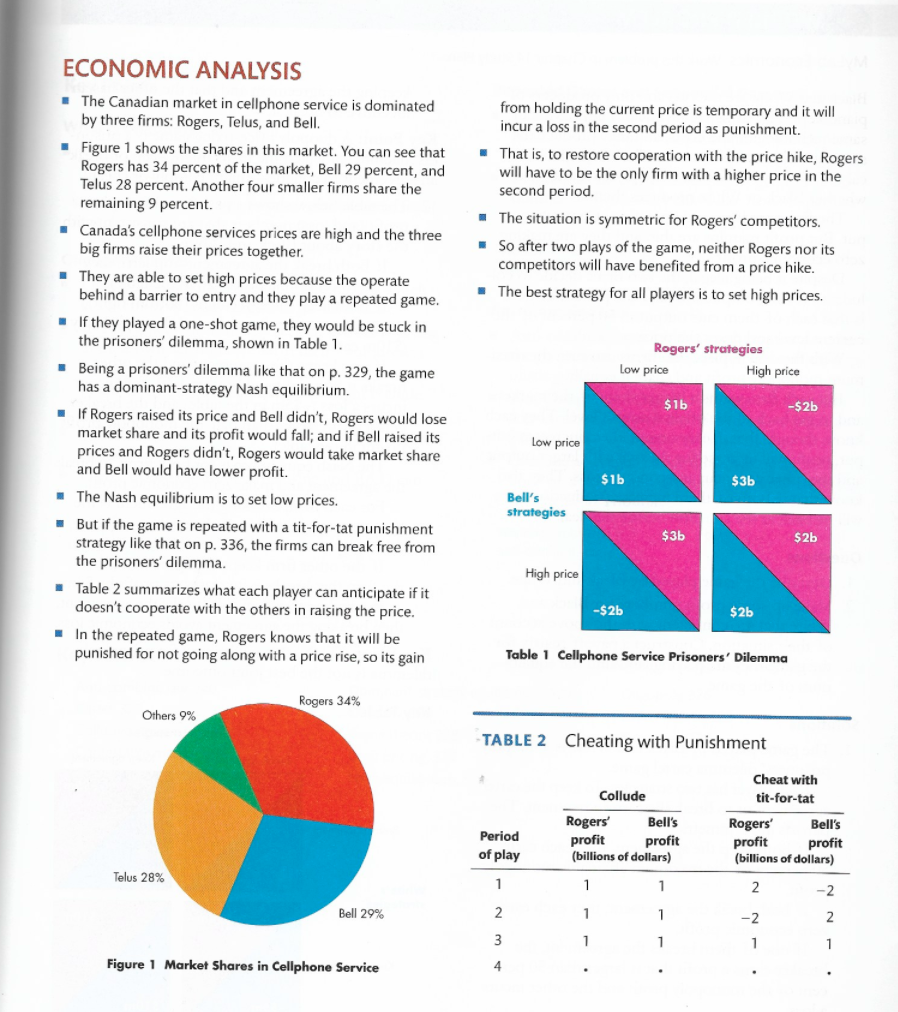Answered step by step
Verified Expert Solution
Question
1 Approved Answer
2. After you have studied Economics in the News on pp. 34445, answer the following questions. a. What are the strategies of Rogers, Telus, and
2. After you have studied Economics in the News on pp. 34445, answer the following questions.
a. What are the strategies of Rogers, Telus, and Bell in the market for cellphone service?
b. If Rogers, Bell, and Telus played a one-shot game, how would the outcome be different?


c. Why is a tit-for-tat punishment strategy needed to get the firms out of a prisoners dilemma? d. How would you expect the entry of a fourth big player, such as the U.S. Verizon, to change the game and its outcome?
Oligopoly Games in Cellphone Service Trudeau Minister Says Canada's Cellular Plans Are Too Expensive Bloomberg News June 5, 2017 Canadas Liberal government is picking a fight with the country's telecommunications giants. Internet and cell services still aren't available for many rural and low-income Canadians, and prices are higher than in other developed countries, Innovation Minister Navdeep Bains said in a speech at the Canadian Telecom Summit on Monday. Access isn't the only challenge, the bigger barrier is price," Bains said. The digital divide is unacceptable." ... Rogers Communications Inc., Telus Corp. and BCE Inc. still own more than 90 percent of the wireless market and dominate television and Internet service across the country. Prices, especially for cellphone service, are generally higher than in Europe and the U.S. Carriers argue this is because Canada, with a small population spread over a massive area, demands larger and more expensive ESSENCE OF THE STORY infrastructure investment to maintain network quality. Rogers, Telus, and Bell (BCE) own more than Bains ordered the country's telecommunications regu- 90 percent of the wireless market. lator to review its recent decision that allows wireless Cellphone services aren't available for many network owners to refuse access for smaller companies rural and low-income Canadians. that don't have their own cell towers in a certain geo- The prices of cellphone services are higher in graphic area. Canada than in Europe, the United States, and other developed countries. That decision effectively shuts down prospects for Cellphone service providers say Canada's small companies like Sugar Wireless, which mostly uses wi-fi population spread over a massive area makes service to connect its users and pays to roam on other their costs high networks when wi-fi isn't available. It's a model that's A recent decision by the regulator allows been employed with success in the U.S. by firms such Rogers, Telus, and Bell to block access for smaller companies to their cellular networks. as Republic Wireless. The Innovation Minister ordered a review of Used with permission of Bloomberg L.P. Copyright 2017. All rights reserved. this decision from holding the current price is temporary and it will incur a loss in the second period as punishment. That is, to restore cooperation with the price hike, Rogers will have to be the only firm with a higher price in the second period. The situation is symmetric for Rogers' competitors. So after two plays of the game, neither Rogers nor its competitors will have benefited from a price hike. The best strategy for all players is to set high prices. ECONOMIC ANALYSIS The Canadian market in cellphone service is dominated by three firms: Rogers, Telus, and Bell Figure 1 shows the shares in this market. You can see that Rogers has 34 percent of the market, Bell 29 percent, and Telus 28 percent. Another four smaller firms share the remaining 9 percent. Canada's cellphone services prices are high and the three big firms raise their prices together. They are able to set high prices because the operate behind a barrier to entry and they play a repeated game. If they played a one-shot game, they would be stuck in the prisoners' dilemma, shown in Table 1. Being a prisoners' dilemma like that on p. 329, the game has a dominant-strategy Nash equilibrium. If Rogers raised its price and Bell didn't, Rogers would lose market share and its profit would fall; and if Bell raised its prices and Rogers didn't, Rogers would take market share and Bell would have lower profit. The Nash equilibrium is to set low prices. But if the game is repeated with a tit-for-tat punishment strategy like that on p. 336, the firms can break free from the prisoners' dilemma. Table 2 summarizes what each player can anticipate if it doesn't cooperate with the others in raising the price. In the repeated game, Rogers knows that it will be punished for not going along with a price rise, so its gain Rogers' strategies Low price High price $ 1b -$2b Low price $1b $3b Bell's strategies $3b $2b High price -$2b $2b Table 1 Cellphone Service Prisoners' Dilemma Rogers 34% Others 9% TABLE 2 Cheating with Punishment Cheat with tit-for-tat Collude Period of play Rogers Bell's profit profit (billions of dollars) Rogers' Bell's profit profit (billions of dollars) Telus 28% 1 1 2 2 Bell 29% 2 1 -2 2 3 1 1 1 Figure 1 Market Shares in Cellphone Service 4 Oligopoly Games in Cellphone Service Trudeau Minister Says Canada's Cellular Plans Are Too Expensive Bloomberg News June 5, 2017 Canadas Liberal government is picking a fight with the country's telecommunications giants. Internet and cell services still aren't available for many rural and low-income Canadians, and prices are higher than in other developed countries, Innovation Minister Navdeep Bains said in a speech at the Canadian Telecom Summit on Monday. Access isn't the only challenge, the bigger barrier is price," Bains said. The digital divide is unacceptable." ... Rogers Communications Inc., Telus Corp. and BCE Inc. still own more than 90 percent of the wireless market and dominate television and Internet service across the country. Prices, especially for cellphone service, are generally higher than in Europe and the U.S. Carriers argue this is because Canada, with a small population spread over a massive area, demands larger and more expensive ESSENCE OF THE STORY infrastructure investment to maintain network quality. Rogers, Telus, and Bell (BCE) own more than Bains ordered the country's telecommunications regu- 90 percent of the wireless market. lator to review its recent decision that allows wireless Cellphone services aren't available for many network owners to refuse access for smaller companies rural and low-income Canadians. that don't have their own cell towers in a certain geo- The prices of cellphone services are higher in graphic area. Canada than in Europe, the United States, and other developed countries. That decision effectively shuts down prospects for Cellphone service providers say Canada's small companies like Sugar Wireless, which mostly uses wi-fi population spread over a massive area makes service to connect its users and pays to roam on other their costs high networks when wi-fi isn't available. It's a model that's A recent decision by the regulator allows been employed with success in the U.S. by firms such Rogers, Telus, and Bell to block access for smaller companies to their cellular networks. as Republic Wireless. The Innovation Minister ordered a review of Used with permission of Bloomberg L.P. Copyright 2017. All rights reserved. this decision from holding the current price is temporary and it will incur a loss in the second period as punishment. That is, to restore cooperation with the price hike, Rogers will have to be the only firm with a higher price in the second period. The situation is symmetric for Rogers' competitors. So after two plays of the game, neither Rogers nor its competitors will have benefited from a price hike. The best strategy for all players is to set high prices. ECONOMIC ANALYSIS The Canadian market in cellphone service is dominated by three firms: Rogers, Telus, and Bell Figure 1 shows the shares in this market. You can see that Rogers has 34 percent of the market, Bell 29 percent, and Telus 28 percent. Another four smaller firms share the remaining 9 percent. Canada's cellphone services prices are high and the three big firms raise their prices together. They are able to set high prices because the operate behind a barrier to entry and they play a repeated game. If they played a one-shot game, they would be stuck in the prisoners' dilemma, shown in Table 1. Being a prisoners' dilemma like that on p. 329, the game has a dominant-strategy Nash equilibrium. If Rogers raised its price and Bell didn't, Rogers would lose market share and its profit would fall; and if Bell raised its prices and Rogers didn't, Rogers would take market share and Bell would have lower profit. The Nash equilibrium is to set low prices. But if the game is repeated with a tit-for-tat punishment strategy like that on p. 336, the firms can break free from the prisoners' dilemma. Table 2 summarizes what each player can anticipate if it doesn't cooperate with the others in raising the price. In the repeated game, Rogers knows that it will be punished for not going along with a price rise, so its gain Rogers' strategies Low price High price $ 1b -$2b Low price $1b $3b Bell's strategies $3b $2b High price -$2b $2b Table 1 Cellphone Service Prisoners' Dilemma Rogers 34% Others 9% TABLE 2 Cheating with Punishment Cheat with tit-for-tat Collude Period of play Rogers Bell's profit profit (billions of dollars) Rogers' Bell's profit profit (billions of dollars) Telus 28% 1 1 2 2 Bell 29% 2 1 -2 2 3 1 1 1 Figure 1 Market Shares in Cellphone Service 4Step by Step Solution
There are 3 Steps involved in it
Step: 1

Get Instant Access to Expert-Tailored Solutions
See step-by-step solutions with expert insights and AI powered tools for academic success
Step: 2

Step: 3

Ace Your Homework with AI
Get the answers you need in no time with our AI-driven, step-by-step assistance
Get Started


